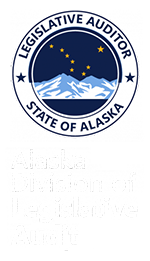Summary: The report offers a number of ways that the department could potentially lower costs in the future. Some of these reductions may be accomplished without cutting services, while others may entail a reduction in services provided by the department. This is distinct from maximizing revenues in that rather than seeking additional funding to offset general funds, these recommendations find ways that the department could be spending less on a task.
Click here for the table of all recommendations for lowering costs
Key Finding for Lowering Costs
- Despite numerous strategic, operational, and financial benefits, video conferencing technology remains under-utilized by DHSS. (pg. 105)
- There are a number of opportunities to increase revenue and reduce general fund expenditures for the Alaska Pioneer Homes. (pg. 139)
Key Recommendations for Lowering Costs
- Combine the facility licensing and certification functions into a single office or new division.
(Recommendation 3.2.C.1)
Although licensed by separate divisions within DHSS, child care homes and centers (licensed by the Division of Public Assistance) and residential care facilities (licensed by the Division of Health Care Services) are governed by the same statute. These licensing functions require considerable travel throughout the state by each division. Of 14 states reviewed, 10 combine health care facilities licensing and certification into a single division or unit within a department. Combining these functions would allow more efficient and effective coordination of travel and personnel. Estimated savings are up to $250,000 annually.
- Designate an existing deputy commissioner to oversee the programs within DHSS that operate institutions.
(Recommendation 3.2.K.1)
DHSS operates three sets of institutions that provide residential care: the Alaska Psychiatric Institute, which consists of one 80-bed facility; the Division of Juvenile Justice, which oversees of eight juvenile justice facilities across the state; and the Alaska Pioneer Homes, which consists of six facilities across Alaska. These facilities have similar institutional administrative support functions, such as food service, facility maintenance, pharmaceutical purchasing and dispensing, recruitment and retention of direct service workers, and invoicing and billing. Currently, these institutional administrative support functions are not comprehensively coordinated. This change would standardize administrative functions and realize efficiencies that can be achieved by consolidating many of the support functions.
- Combine all program integrity and compliance units across the department, including provider enrollment and the surveillance and utilization review subsystem.
(Recommendation 3.3.B.1)
Investigation and program integrity efforts vary widely across the divisions. Combining units would allow DHSS to conduct risk analyses to best deploy resources to prevent, detect, and investigate fraud, waste, and abuse for all department programs and services. The benefits of combining these functions include the opportunity to consolidate analytical capabilities and systems to conduct risk assessments. Additionally, overhead can be reduced, and travel can be coordinated.
- Elevate the priority of current and future video conferencing projects to expand video conferencing capabilities of the department.
(Recommendation 7.2.1)
Video conferencing technology allows visual and audio communication to take place across the state without the high cost of in person meetings. Although not fully utilized, DHSS has been implementing video conferencing technology for the past several years for many purposes including staff meetings, mental and medical healthcare interviews and diagnostics, family visitations, and judicial proceedings. Certain court-related usage of video conferencing technology may require legislative changes and would require partnering with the judicial branch. Video conferencing use for health care is expensive and should only be considered as funds are available. This will increase efficiency and reduce travel-related expenses across all divisions.
- As new video conferencing capabilities come on line, the commissioner should establish a target reduction in travel of 10 percent for the first year and 20 percent in the second year.
(Recommendation 7.2.2)
DHSS spends nearly $4 million per year on non-Medicaid travel. By increasing the use of video conferencing and decreasing the need for travel, the department could target savings in this area. The full cost of implementing an expanded video conferencing system is not known; however, conservatively targeting a net savings of 10 percent in the first year to account for start-up costs, the department would save $400,000 annually. Savings targets can be increased in subsequent years.
- Review staffing levels and identify ways to reduce staffing ratios to be more in line with other state-operated assisted living facilities, with due consideration given to variations in care models.
(Recommendation 8.1.I.1)
While the State of Alaska does not prescribe statutory minimum staffing ratios for nursing homes or assisted living facilities, Pioneer Homes has substantially higher staffing ratios than other states’ minimum standards where they exist. The states with the highest staffing ratios are Colorado (1:6), South Carolina (1:8), and South Dakota (1:10). Alaska Pioneer Homes has an approximate average staffing ratio of one direct care staff per 3.8 residents — significantly higher than the minimum ratios required in these three states.
- The State of Alaska should consider managed competition or privatization for the Alaska Pioneer Homes.
(Recommendation 6.2.1)
An alternative to privatization is a process called managed competition. Many public agencies contract for services with private firms without considering whether a job can be done cheaper and better in-house by public employees. Managed competition analyzes the real cost of an operation or service and then designs a competitive bidding process that is open to in-house bidding by government agencies and/or workers, as well as outside private bidders.

